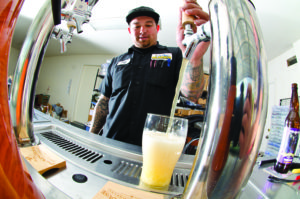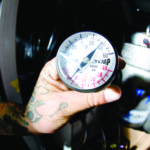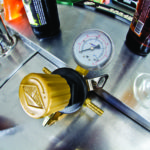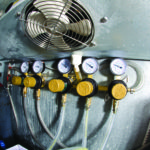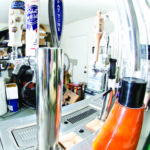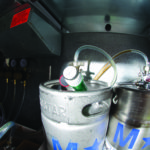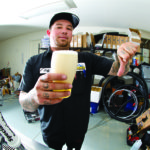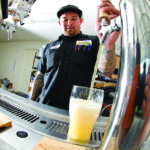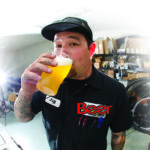Kegerator Hop-Up Pour beer better at home!
It’s safe to assume that everybody reading this magazine either already has a kegerator or dreams of owning one. Beer on tap at home? Isn’t that the real American dream (or Canadian dream, for our friends to the north)? Many of us who bought a kegerator probably never researched what makes a good one, or shopped for one by price. The reality is, if you aren’t a draft specialist, you might be having issues pouring beer. We decided to use our black book and contact Glacier Design Systems, a draft line specialist, to go over what the average kegerator owner can do to pour colder, less foamy beer. Jeff Gage invited us into his garage, where we went over all the things you can do to be a draft master.
Temperature and Pressure
These are the two key points to pour beer at any scale, from 1 to 100 taps. Both of these factors rely on each other, and the more difficult to control is temperature. Cold beer is a relatively modern-world term, but it controls the amount of carbonation the beer can retain.
Temperature
38 degrees is the target temperature for storing, and pouring, beer. You can pour at different temperatures, but that just changes a few things we’ll discuss later. The first thing to do in your home system is to get an accurate temperature reading. There are a few ways to do this. Some have a thermometer built in, but unless it’s actually in liquid, it isn’t really that accurate. A wet bulb reading is the most accurate way to know the temp of that liquid gold wrapped in stainless. Jeff showed us a simple way to make one. Get an old water bottle and fill it with water. Then stick a thermometer from any store that sells cooking gadgets (we recommend one for freezers; it will have a smaller temp range) in the kegerator with the beer. The next step? Wait. Both the keg and the water bottle should be left alone for 24 hours. This makes sure that the beer cools to the temperature your system will maintain, and you can see where it sits.
Pressure
Every beer on the planet has a certain amount of CO2 in it, and a simple physics class will remind you that the colder the beer, the more CO2 can be dissolved in the beer. This is where that 38-degree friendship comes into play. At 38 degrees, you set the pressure of the keg to hold the CO2 in the beer as the brewer intended. If the temperature goes up, the beer will want to “burp” out the CO2 and when it pours, the beer will foam. To solve this, you would increase the CO2 pressure, but that will eventually add carbonation to the beer and cause foaming issues later in the keg’s life (see the sidebar on over-carbonation).
Most beers require between 12 and 15psi of CO2 to maintain the beer’s intended level. If the CO2 volume of the beer is matched by the CO2 pressure of the tank, then it will stay equal. The problem we have is that lots of breweries don’t even know how much they put into their beer, so it’s hard to be that exact. The other complication is that we actually use CO2 to move the beer out the tap, and some people think that this pressure should be adjusted to pour faster or slower, which should never be done.
It is important to point out that the temp is the deciding factor here, and if the temp goes up just 10%, or to 41-42 degrees (which is where lots of craft beer nerds like to drink their beer), that means you will have to increase pressure to keep the beer from foaming, as it will want to give off 10% of the CO2 volume, since that’s all it can hold in solution at that temperature.
Now that we have some basic “edumacation” on the science of CO2, we can keep it simple and go over some ways to get the beer cold, pouring right and, ultimately, saving you money. Remember: every drop of beer that foams over the glass is wasted unless you drink the spill tray.
Parts
Most home, and even commercial, kegerator are missing a few key parts to actually keep the beer cold, therefore requiring higher pressure to prevent foam initially. Let’s go over where the problems lie.
Tower
The part that we all look at and smile at is actually one of the main problems in pouring beer. Remember that the beer has to be at 38 degrees or less, and if at any point the temperature goes up, CO2 will try to leave the beer, and that means foam! Most of the home systems are air cooled, and if you stick your face underneath and look up, you’ll see a pretty uninsulated tower and realize that there is minimal air going up into the tower. Remember that heat rises? So that means if you have 43-degree air in the box, it will go to the highest point: the top of the tower. Thankfully, there are a few tricks to help keep that tower, and beer, as cold as it can be.
Fan
There are several kegerator fans designed to circulate the air up the tower and keep it cold. Some can be added in without the help of an electrician (depending on if your system was designed to take one), or you might have to add one in and either hire an electrician or drill a hole in the box and use another outlet. Just be smart, and if you drill, seal it up. The fan takes the colder air and forces it up the tower, cooling the beer lines and tap. The actual metal part of the tap should be cold, and if really cold will actually sweat. The tower itself shouldn’t be as cold; if it is, you should look into insulating the outside to keep the transfer of heat from the outside in.
Tower Design
The actual design of most kegerators is flawed, even with a fan. If you blow air into a straw with one end closed off, you can feel what is happening as you try to blow colder air up the tower. It’s not really ideal. There are towers that are called pass-throughs that allow air to circulate up and around and cool the tower better. You see those giant T tap systems and if you think about that straw example, you’ll see why the outer taps will generally not be as cold and therefore will foam more. The “U”-shaped pass-through design will cost a bunch more to get or install, but it’s a better design.
Beer Line
Inside every beer system is a beer line. That beer line can vary in diameter from 1/4 inch to as much as 5/8 inch. As a general rule, if you don’t have about 7 feet of line in the box from the keg to the tap, you might not have enough restriction. That will result in beer that moves too fast, resulting in “rocketing.” Rocketing means the beer pours too fast and shocks the beer as it enters the glass, causing you to pour foam. Adding line means the beer moves slower, and you will reduce this problem. A simple way to see if your beer is pouring too fast is to time how long it takes to pour 16 ounces. It should be around 7 seconds, or 2 ounces per second.
Tips
- Never try to pour a beer with the tap being pulled halfway, or a little, to try and pour slower. A tap system is designed to be on or off, and putting it in the middle will actually result in foam. It’s like putting your finger over a hose.
- Placement matters. If the room is hot or the kegerator is in the sun, the refrigeration unit is going to work harder, and if under-spec’d (as most cheap home units are) will have trouble keeping the beer cold.
- Insulating the inner lining of the tower will prevent heat transfer into the tower.
- Temperature is king; keep the door closed.
- Don’t buy cheap. A good system will save you money over time.
Over-Carbonation
This results when you have more CO2 pressure than the beer was made with. If the temperature is higher than 38 and you have to adjust the pressure higher to compensate, eventually the beer will start to over-carbonate. CO2 is only being applied from the top of the keg, and the beer is being poured from the bottom. The CO2 actually will start over-carbonating the top of the beer and slowly moving down. Home brewers shake kegs to get beer to carbonate faster and evenly, or use carb stones to bubble the CO2 through the beer. Most people won’t realize that the beer was over-carbonated until the beer is almost gone. If you have the pressure and temp steady and the beer becomes foamier, the keg is drained?? that generally means you have the pressure too high.
<sidebar>
Rate of Change
If you are constantly looking at your keg, you are warming it up. Beer will get warmer way faster than colder because the difference in temp is bigger when you open the door. In the summer if it’s 80 degrees and you expose the keg to that temperature, that difference should be 42 degrees (80-38=42). That means the keg will start to warm up fast, and remember what I said about 10% being just 3.8-degrees difference. That’s a big change. When you close the door, and the fridge is set to 36 degrees, if the beer is now 42 degrees that means the difference in temp is only 6 degrees, and that means it’s going to take much longer to drop the temp back down to 38. So the rule is, keep the door shut unless you need to change the keg. Your mom told you this when you were young. It was good advice.
Pouring right
There’s nothing better than having beer on tap at home. Home brew, or brewery beers out of a keg, are awesome to have. So if you’re not pouring a proper pint every time you decide it’s happy hour, it’s time to get it right.



